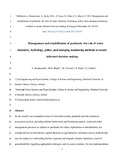Management and rehabilitation of peatlands: the roles of water chemistry, hydrology, policy, and emerging monitoring methods to ensure informed decision making
Date
2022-04-03Author
Monteverde, S.
Healy, Mark G.
O'Leary, D.
Daly, E.
Callery, O.
Metadata
Show full item recordUsage
This item's downloads: 31 (view details)
Cited 0 times in Scopus (view citations)
Recommended Citation
Monteverde, S., Healy, M. G., O'Leary, D., Daly, E., & Callery, O. (2022). Management and rehabilitation of peatlands: The role of water chemistry, hydrology, policy, and emerging monitoring methods to ensure informed decision making. Ecological Informatics, 69, 101638. doi:https://doi.org/10.1016/j.ecoinf.2022.101638
Published Version
Abstract
As the world's most abundant source of terrestrial carbon, peatlands provide numerous ecosystem services, including habitat biodiversity and freshwater quality. Land and water management practices in relation to peatlands, for either exploitation or rehabilitation, are complicated by several factors: spatial diversity in geochemistry; laborious survey methods that may be subject to confounding factors; regional and irregular climate variations; a lack of generalizability regarding appropriate strategies; and, in some countries, by non-implementation of water quality assessment policies for pollution control and land use. Such factors raise uncertainty in the effectiveness of restoration and rehabilitation strategies, while modern peatland management looks to develop land use schemes that offer minimal risk to the environment. The aims of this paper were to (1) investigate the disparate factors influencing peatland management which confound appropriate interventions for enhanced water quality (2) examine how non-implementation of national policies for water pollution control may result in adverse environmental impacts, and (3) propose an innovative peatland management methodology for a detailed and robust land analysis with water quality being the primary consideration. The paper suggests that optical, radar, and radiometric remote sensing methods may be used to identify management zones within a peatland, that may require variable management strategies during restoration. Satellite remote sensing and Earth observation methodologies are well documented; hence, the prospect and properties of a less documented airborne electromagnetic approach


